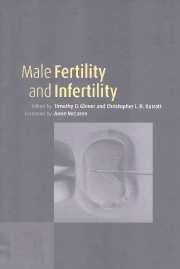Book contents
- Frontmatter
- Contents
- List of contributors
- Foreword by Anne McLaren, FRS
- Preface
- Acknowledgements
- Part 1 Biological perspectives
- 1 The evolution of the sexual arena
- 2 The role of sperm competition in reproduction
- 3 Sperm production and delivery in mammals, including man
- 4 The local control of spermatogenesis
- 5 Some misconceptions of the human epididymis
- 6 Transport of spermatozoa to the egg and fertilization success
- 7 Changes in human male reproductive health
- Part 2 Implications of the new technologies
- Index
7 - Changes in human male reproductive health
from Part 1 - Biological perspectives
Published online by Cambridge University Press: 09 August 2009
- Frontmatter
- Contents
- List of contributors
- Foreword by Anne McLaren, FRS
- Preface
- Acknowledgements
- Part 1 Biological perspectives
- 1 The evolution of the sexual arena
- 2 The role of sperm competition in reproduction
- 3 Sperm production and delivery in mammals, including man
- 4 The local control of spermatogenesis
- 5 Some misconceptions of the human epididymis
- 6 Transport of spermatozoa to the egg and fertilization success
- 7 Changes in human male reproductive health
- Part 2 Implications of the new technologies
- Index
Summary
Introduction
During the past two decades, a number of reports have appeared which have raised serious concerns about the development of reproductive problems in animals and man (Colborn et al., 1996; Cadbury, 1997). There have been reports of alligators with abnormal male genital development (Guillette et al., 1994) and of reproductive changes in fish and birds (Giesy et al., 1994; Sumpter & Jobling, 1995). At the same time, there have been controversial reports of changes in human semen quality (Carlsen et al., 1992; Auger et al., 1995; Irvine et al., 1996), alongside reports of an increasing incidence of congential malformations of the male genital tract, such as cryptorchidism and hypospadias (Kallen et al., 1986; Ansell et al., 1992), and of an increasing incidence of testicular cancer (Adami et al., 1994; Hoff Wanderas et al., 1995). However, there is controversy over whether or not these reported changes in male reproductive health are genuine (Setchell, 1997), and if so, what the causes and implications are, in particular the implications for clinicians caring for couples with infertility.
Testicular cancer
Although many of the changes seen in male reproductive health are controversial, there seems little argument that testicular cancer is increasing in frequency, with unexplained increases in the age-standardized incidence observed in Europe (Adami et al., 1994; Bergstrom et al., 1996; Hernes et al., 1996) and the USA (Devesa et al., 1995; Zheng et al., 1996).
- Type
- Chapter
- Information
- Male Fertility and Infertility , pp. 128 - 146Publisher: Cambridge University PressPrint publication year: 1999



